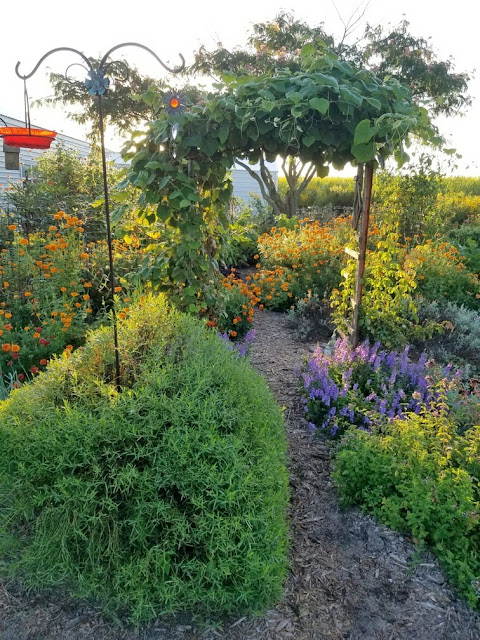I had a post all ready to call an end to the garden season. We had a week in late October that was downright frigid, with freezing nighttime temps nearly every night, and with no sun at all during the days of maximum 50's temps. We even had snow covering the ground for two days, and I didn't go outside, much less to the garden, which I figured was already toast by then.
Much to my surprise, when the weather came back up above freezing, only some raggedy remaining basil had been damaged! The tomatoes looked fine, the peppers looked fine! Bizarre, and pleasing.
This was the last, I figured just before the dip, of the roses:
 And, these were the vegetables I gathered that were still edible the day before the first dip below freezing:
And, these were the vegetables I gathered that were still edible the day before the first dip below freezing:
 And, these were the vegetables I gathered that were still edible the day before the first dip below freezing:
And, these were the vegetables I gathered that were still edible the day before the first dip below freezing: But, take a look at the tomato plants a week later, after the freezing temps, when I went back to the garden:
But, take a look at the tomato plants a week later, after the freezing temps, when I went back to the garden:And the peppers:
Unreal.
These were the tomatoes I had harvested in the couple of weeks before the dip. They were much nicer than any I'd been getting earlier in the season, which often had large cracks and some feeding damage. These look like I sprayed them with pesticides, which I didn't:
I had planted arugula, which I expected would be okay, and it was. Just hardly any bigger than the week before:
The lettuce I had planted kept growing, which wasn't a surprise.
 Even the little cucumber plants, which I knew at the time I planted the seeds were a long shot, didn't die.
Even the little cucumber plants, which I knew at the time I planted the seeds were a long shot, didn't die.This little Cherokee Spirit echinacea didn't even bat an eye: Unsurprising, though, are the cabbages. They can take a good deal of cold, and they look great:
Unsurprising, though, are the cabbages. They can take a good deal of cold, and they look great:
 Unsurprising, though, are the cabbages. They can take a good deal of cold, and they look great:
Unsurprising, though, are the cabbages. They can take a good deal of cold, and they look great:'Primo Vantage'
'Omero'
My latest attempt to get a red-stemmed rhubarb, 'Kangarhu', is in. Fingers crossed that the stems will be red when they're harvestable next spring.
This was my immediately previous purchase, which did have red stems when I bought it last spring, and is what has happened to each and every other of the several varieties I've tried. So disappointing. They taste just as good as red-stemmed rhubarb, but aren't as pretty in a pie.
The roses had a bad year, but they did have one beautiful surge the first of October when it wasn't so humid.
'South Africa'
'Poseidon'
'Shazam!'
'Neptune'
Happy Halloween! Wear your masks. You know what I'm talking about. The Covid-19 pandemic is about to meet the regular flu season.
And VOTE!
UPDATE: Later that same day...
NOW it's over. The temperature dipped to 29 overnight. What a shame, after all that last week, and the hope that tomatoes would still be harvestable for a little while longer (the rest of this week is supposed to be warm and sunny with night temps in the upper 40s and low 50s).
Alas, it's not to be. The fruit that's there is thawed from frozen, and turned to mush. The leaves are the same and won't recover.
 The little cucumbers are dead as doornails. Some of the peppers may yet struggle on, but it was the tomatoes I was looking forward to.
The little cucumbers are dead as doornails. Some of the peppers may yet struggle on, but it was the tomatoes I was looking forward to.UPDATE: I set up a post to be published in August with pictures, but forgot to finish it, so here it is, out of place.


























































